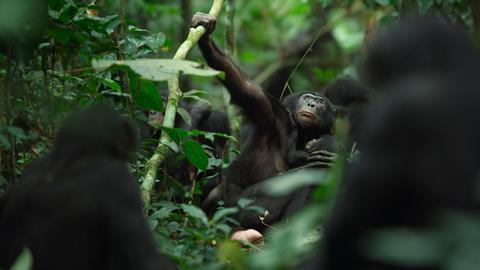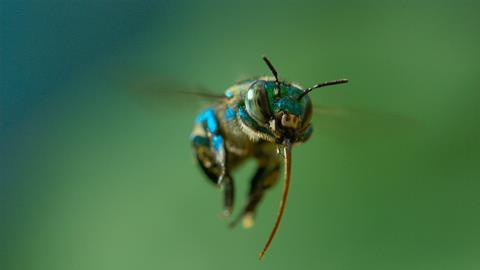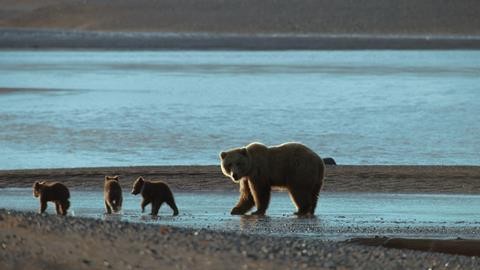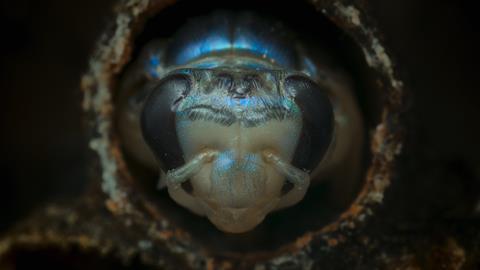Seven-part docuseries examines matriarchs from around the natural world

Evolutions Bristol provided full picture post on National Geographic and Disney+ docuseries Queens.
The seven-part natural history docuseries produced by Wildstar Films showcases formidable matriarchs from around the world including Elephant, Hyena, Bears, Orca, Bonobos, Ants and Jewel Bees. It is now available to stream on Disney+.
The Evolutions team was made up of colourist Blair Wallace and online editor Jo Curtis in collaboration with Moonraker VFX and the finishing and mastering team at the Bristol Evolutions facility. The delivery to Disney+ was a UHD Dolby Vision grade in HDR with accompanying SDR trim grade pass.

“Natural History grades normally start with an assessment of the camera formats, tricky but essential behaviour footage tests that have to make the cut and a view on how best to treat the texture…” recalls Wallace. Colour workflow, texture management, VFX intermediates, resolution formatting / framing all have a part to play before the ‘look’ can start to be established. “Having the production team just down the road enabled us to have multiple sessions where we could carry out tests with little fuss as the films made their transition from an HD standard dynamic range proxy offline to the very different ‘world’ of UHD HDR. Tests are a fantastic opportunity to start the ‘colour conversation’” Wallace added.
The series was mastered in UHD Dolby PQ via an ACES colour workflow identifying each camera via its metadata producing EXR sequential files as intermediates to move around the facility, as well as to and from VFX. ACES pregrade intermediates were also created, handling them in Flame with the online editor Jo Curtis and reconforming in Baselight before final colour sessions began. Curtis said “Due to the nature of the UHD HDR workflow, I completed a lot of the traditional online work as part of my pregrade online. Each episode presented their own unique requirements for the pregrade / online, which is where Flame really comes in to its own as an incredibly powerful online tool.”

Reflecting on her experience working with the Wildstar team on this series, Curtis adds “It was a pleasure and thoroughly satisfying experience both professionally and personally. Working on this innovative series with such a strong creative female-led team was a real privilege.”
The grades needed to bring together a diverse collection of captured footage and deliver on guiding the viewer to important action in frame. The look needed to be natural but also required subtle stylisation to set the episodes apart as well as deal with consistency. Accessing both noise reduced and un noise reduced material in the grade, Wallace was able to choose, blend or isolate texture issues applying texture equaliser, texture highlight or sharpen where appropriate. Blair added: “With some environments cooler shadows were created to give colour separation helping the ‘characters’ stand out from their environments as nature doesn’t always provide colour separation or lighting! Queens was a truly big and exciting series to have had the pleasure to grade”.

In the Tiny Queens episode, cinematographer Andrew Lawrence mounted both a Black Magic Pocket Cinema 4K camera for full res and a Hawkeye for all the XYZ coordinates to a drone to provide the incredible flight scenes. Evolutions received proxy plates with a specific stabilisation tool applied called Gyroflow. The challenge the Evolutions workflow team faced was that the Gyroscope standalone tool did not support ACES or most of any HDR colour mapping at the time.
In the grade preparation, Evolutions were able to load the Gyroflow OFX tool in Resolve and remap the Hawkeye data to the BMPC4K in a full ACES colour mapped workflow to their uncompressed EXR sequences allowing for a full resolution Dolby Vision grade.

Wildstar Films executive producer Chloe Sarosh remarked: “We purposefully wanted to create a series full of different worlds and characters where no two episodes were even remotely alike visually, sonically or in their storytelling. That meant that every episode was technically unique – long lens, hyperlapse, dark jungles, colour at night – and yet somehow they all needed to feel cohesive. That’s the challenge we dumped in Evolutions lap.”
Ilaira Mallalieu, episode producer director for Tiny Jungle Queens, said: “The forest the bonobos live in is a challenge for filming and grading; dark, but with spots of very bright sunshine. The bonobos themselves are incredibly expressive, and we really wanted to see their faces clearly, to see the light in their eyes.

“We wanted each of the different characters and locations in Tiny Jungle Queens to have their own look; the interior of the bee’s nest needed to feel dark, secretive, but still retaining the texture of the tree. The exterior flying shots serve as a colourful tour of the jungle world; vibrant and lush, but we still needed to be able to separate the green of the bee from the green of the forest, and the ants’ nest needed a different look again. We used a lot of different cameras, lenses, and lighting techniques to capture all the footage, and so creating a consistent look for these scenes was a challenge.
“The hyperlapse was particularly difficult – we wanted to be able to show the movement of leafcutter ants through the forest, but because this is a character led film, we also wanted to be able to pick out the real time movements of our heroine ant. This required each section of the leafcutter ant trail to be filmed multiple times with different cameras and lenses and blended together so that we could choose when we wanted to highlight our ant in amongst the blur of the trail. This was a mammoth task as the shot was almost 8000 frames long, and required close collaboration between our VFX company Moonraker, and Blair & Jo in the grade and online.”








No comments yet